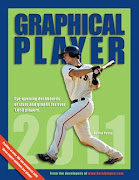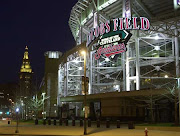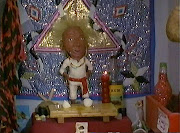
Well, it looks like every sports writer on the planet beat me to the annual All-Star Game snub list. I normally cringe at the All-Star selections, but I really can't find much fault with the selections this year. Hanley Ramirez should have at least been picked as a reserve and Kevin Youkilis is an arguable snub. Carlos Beltran in the starting outfield ahead of Matt Holliday is an obvious case of ballot stuffing. My biggest issue is Ivan Rodriguez (his defense doesn't even save him this year; worst in 4 seasons) starting ahead of Victor Martinez.
With the exception of Beltran, the NL starters look solid, especially Prince Fielder and Russell Martin; great first-time selections there. Vlad and Ichiro were the only non-Yankee/Sox/Tiger players who cracked the AL starting roster, but it's hard to argue against the players selected (except Pudge, of course). Overall, the fans didn't embarass themselves this year, which is nice.
Like most baseball fans, I enjoy the All-Star Game quite a bit, despite my frequent criticism. There are few times so many great players are assembled on the same field and it's always fun to see the Cleveland representative in action (three this year, woo-hoo!). You can tell the players and their families get a kick out of attending the game too. The baselines during the Homerun Derby often look like a family reunion amongst the players; many are close friends, but have little off-time during the busy season. Not to mention the amount of publicity and revenue MLB and the host city rake in from the festivities.
So if the industry, fans, and players all love the All-Star Game, what's there to complain about? Nothing, actually. I have no problem with the game itself, it's the outdated connotations associated with an All-Star selection that I disagree with.
The All-Star Game is voted on by the fans, for the fans. A large majority of fans who vote for the starting rosters do so with their favorite players in mind, not who has the best OPS or strikeout to walk ratio. Given the recent trends in the voting, stats and pure performance play a complementary role, at best. If sportswriters, historians, and Hall of Fame voters insist on using a popularity contest as a measure of a players legacy or skill, they are kidding themselves. It's obvious being voted in as an All-Star has lost much of its significance at this point and should be taken with a grain of salt.
Obviously, the most popular players tend to be some of the best, but they are not always deserving. The fans often ignore outstanding and deserving players, sending players who are not the best at their position
that season to the exhibition. Isn't the point of selecting All-Stars to honor the players who are playing the best baseball at that point? There are far too many questionable or flat out bad selections each year to continue to justify the significance currently associated with a selection.
Now, the core of my argument is only applicable to the starting fielders, as the pitchers and reserves are selected by a combination of major league players, managers, and the Commissioner's Office. There is certainly something to be said for being recognized by one's peers as a premier player and these selections tend to carry more clout than the fans' selections.
According to
Baseball Almanac, "All-Star teams were originally selected by the managers and the fans for the 1933 and 1934 games. From 1935 through 1946, managers selected the entire team for each league. From 1947 to 1957, fans chose the team's starters and the manager chose the pitchers and the remaining players. From 1958 through 1969, managers, players, and coaches made the All-Star Team selections. In 1970, the vote again returned to the fans for the selection of the starters for each team and remains there today."
Out of all the combinations stated above, having the managers, players, and coaches select the team is the one with the least potential for bias. The more diverse and knowledgeable the selection committee, the better the final representation. While a single manager will certainly be looking for the best roster possible, it's not a stretch to say selections are still made partly on reputation and familiarity (i.e. their own players).
A strong bias has existed in All-Star Game selections since the exhibition's inception 74 years ago. Yet, sportswriters have been using the selections as a measure of a players worth for just as long. All-Star selections are even written on a player's Hall of Fame plaque. What is it that causes supposed experts on the sport to ignore the inherent flaws in being chosen as an All-Star?
Well, my theory is that it provides a definitive link between a player's career and the fans. The fans' interest is stirred when they know they have a say in how a player's career may play out; seeing recognition of their vote on a Hall of Fame plaque is just an added thrill. This link is used in recounting a players performance in sports articles because it is an easy point of reference for the casual fan. The fact that a selection is often a
misleading way to compare players' careers is poor journalism. I could cite many examples, but to start:
Dmitri Young - 2 time All-Star
Omar Vizquel - 3 time All-Star
Shown a difference of one selection, which player do
you think has had a better career?
One area where All-Star selections may be viewed as a measure of a player's career can be derived from the Hall of Fame's voting criteria: "voting shall be based upon the player's record, playing ability, integrity, sportsmanship, character, and contributions to the team(s) on which the player played." As much as I hate citing intangibles as a measure of a player's career, they are stated right there in the selection requirements. A player's
character could certainly be reflected in the number of All-Star appearances, since it shows good standing with his fans and peers. However, this does not excuse the
lack of All-Star selections for overlooked and deserving players. Just how many genuinely bad guys are there in the sport anyway? I can see (hypothetically) choosing Fred McGriff over Albert Belle because one is an upstanding guy and the other is uh, rude, but how often does a scenario like that come up?
The Mid-Summer Classic exists for the fans, but would you let the fans vote on who gets into the Hall of Fame, too? Of course not. So let the fans have their fun with the exhibition games and leave the true measure of a players career to the players pure performance. The great thing about baseball is that every major award except a series title can be measured by statistics. The All-Star Game isn't based on statistics and that's fine; just don't act like it is.















